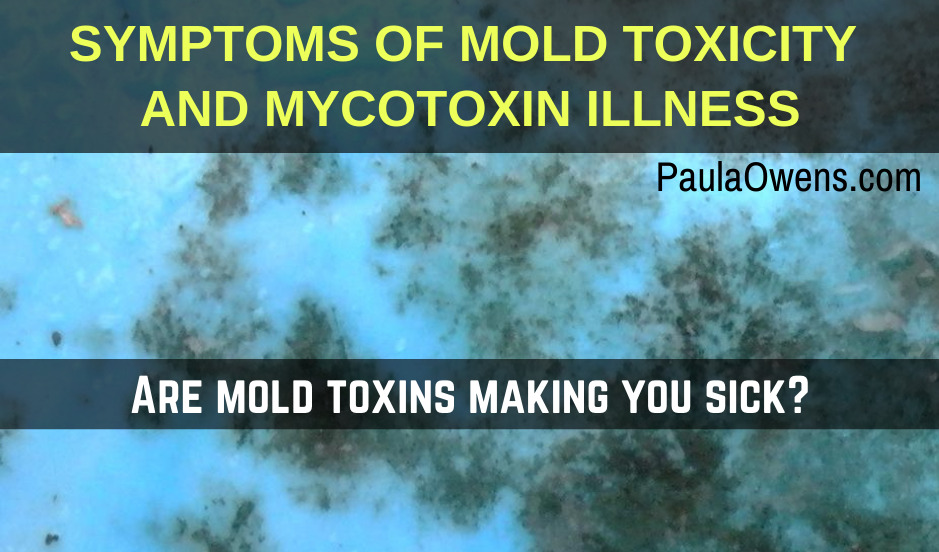
 Mold is a fungus that is known for its ability to grow on almost anything that has moisture, oxygen and organic materials. Mold thrives under many conditions, especially in warm, wet, humid environments. However, even dryer environments like Arizona are notorious for mold.
Mold is a fungus that is known for its ability to grow on almost anything that has moisture, oxygen and organic materials. Mold thrives under many conditions, especially in warm, wet, humid environments. However, even dryer environments like Arizona are notorious for mold.
Some molds reproduce by making mold spores that release mycotoxins (poisons released from mold or fungus). Mycotoxins can also grow on foods.
Mycotoxins suppress the immune system and inactivate white blood cells causing many adverse symptoms, serious health problems, mold toxicity and mycotoxin illness.
Many factors can play a role in mold toxicity from water damage in your home, school or workplace, to indoor humidity levels, genetic susceptibility, and your unique immune function.
Mold poisoning can cause Chronic Inflammatory Response Syndrome (CIRS). CIRS is the body’s out of control inflammatory response to toxins such as mold spores, mycotoxins or biotoxins in tick or spider bites. These toxins can cause a cascade of inflammatory and hormonal changes leading to tissue damage and symptoms such as fatigue, pain, digestive problems, sleep disturbances, and neurologic symptoms.
Mycotoxin Exposure
Exposure to mycotoxins can occur through
- Physical or dermal contact where they’re absorbed through the skin
- Inhalation when in a home or building with mold growth
- Oral ingestion through mold-contaminated foods
Sources of Mold: Where Mold Hides
- Foods with the highest mold content: Grains, including whole grains, factory-farmed grain-fed animal protein, nuts, peanuts, peanut butter, cereals, bread, beans, legumes, soybeans, wine, beer, sugar, cheese, dairy products, cured meats, coffee beans, dried fruit, apples, berries
- Inside your body: in the sinuses, nasal cavity, respiratory tract, the gut, brain, liver, lungs, heart, kidney, bladder, urinary tract and other tissues and organs in the body
- HVAC systems, condensation lines, air ducts
- Leaky roofs, chimneys and vents to the outdoor where the area has not been sealed and caulked properly
- Ceiling tiles, drywall, fiberglass insulation
- Leaky faucets, window leaks
- Basements, attics, crawl spaces, sump pumps
- Behind the walls, sinks, the dishwasher, ice maker, the shower or bathtub
- CPAP breathing apparatuses used for sleep apnea
- Breast implants
- Pet food
- Fish tanks, house plants, plastic coffee makers
- Marijuana
- Washing machines, refrigerators
- Homes, workplace, schools, churches, office buildings, apartments, hotel rooms, vehicles
Symptoms of Mold Toxicity & Mycotoxin Illness
Because many signs and symptoms of mold toxicity are invisible to everyone else, it often goes unsuspected until symptoms become disabling.
Not everyone is affected in the same way. Even those living in the same home may experience different symptoms, and others may not experience any symptoms.
- Fatigue, fibromyalgia
- Chronic coughing, excessive throat clearing
- Sinus infections, nasal/sinus congestion, postnasal drip
- Respiratory problems, frequent asthma attacks, shortness of breath
- Brain fog, poor memory, unable to concentrate, neurological changes, cognitive decline
- Frequent infections
- Headaches
- Nausea, vomiting
- Nose bleeds
- Frequent urination
- Histamine intolerance, multiple food sensitivities, chemical sensitivities, allergic reactions that mimic seasonal allergies
- Digestion problems, diarrhea, heartburn, bloating, gas
- Immune suppression, autoimmune disorders
- Vertigo
- Sugar, alcohol or carb cravings
- EMF sensitivity
- Tingling or numbness in hands and feet
- Psychological symptoms: depression, anxiety, behavioral problems, OCD, emotional changes
- Joint and muscle pain, ice pick pain
- Significant weight gain despite diet and lifestyle choices
- Skin rashes, itching
- Body temperature changes, sweating (especially at night)
- Poor sleep, insomnia
- Static shocks
- Metallic taste in the mouth
- Itchy, watery eyes, blurred vision
What to do if you suspect mold toxicity or mycotoxin illness
The first and most crucial step is to identify where the mold is located and to get away from it.
If you continue to live or work in a moldy, water damaged environment, any therapeutic treatment will not help.
- Are there any visual signs of mold? Just because you don’t see it, doesn’t mean there isn’t a mold problem.
- Do you smell a pungent, musty, moldy odor?
- Prior flooding, water damage or a damp basement?
- Is there condensation on the windows?
- Did your symptoms or sickness start when you moved to a new home or a different job?
- Are there children or pets in the home? Are they sick also? Chronic health conditions, allergies, etc.
- Do you feel better when you’re on vacation? If you suspect you’re sick from mycotoxins and mold toxicity, leave the environment for 10-14 days and notice if you feel better. Be sure you’re not staying at another water-damaged, moldy environment though!
Some people with mold toxicity still feel sick after removing themselves from the moldy environment. These people have a condition known as Chronic Inflammatory Response Syndrome (CIRS).
Test to Assess for Mold Toxicity
- In addition to a detailed health history, timeline, individual subjective symptomology, assessing G.I. function, your environment and prior exposure, lifestyle, toxic load and basic lab work, further testing may be warranted especially if you’ve been sick with no known cause and exposed to mold or a water-damaged environment.
- If you are unsure whether mold is present or the extent of water damage, a mold inspection can be helpful. Hire a trusted indoor environmental professional (IEP) to inspect your home or office (and any new home or residence you plan on moving into)
- If there has been extensive water damage, flooding and detection of mold toxicity and mycotoxins, consider hiring a certified mold remediator. Stay elsewhere during the remediation.
- Depending on the extent of the mold toxicity and damage, you may need to dispose of mold-infested items that were present during any flooding or water damage including furniture, drapes, books, clothing, bedding, rugs, carpet, dog beds, and other porous items
- The lab test used in my practice to assess an individual’s level of mycotoxins is the Mycotoxin Panel
- An ERMI test. The ERMI test assesses mold mycotoxins in your environment. This is a DIY test that looks for the DNA of molds in your home (or office) dust. Order an ERMI test.
- Visual Contrast Sensitivity (VCS) test is a simple test that can identify possible exposure to mold and mycotoxins. Since certain molds have neurotoxic effects, exposure can manifest as a neurological symptom, such as impaired vision.
Prevent Mold Growth & Detox from Mold Toxicity
The most crucial step is to identify where the mold is located and to get away from it. Removing yourself from the mold- and mycotoxin-contaminated environment is the first step toward healing. If you continue to live or work in a moldy environment, the therapeutic treatment will not help, your symptoms will worsen, and your health will progressively decline.
You cannot heal in the same environment where you got sick.
Use Food as Medicine to Detox from Mold Toxicity
- Consume anti-inflammatory, organic, nutrient-dense, low-mycotoxin foods to support mitochondrial function, heal, encourage detoxification and prevent mycotoxins from growing, thriving and surviving inside your body.
- Healthy fats: avocado, grass-fed organic butter, ghee, extra virgin olive oil, coconut oil, black cumin seed oil
- Organic vegetables, leafy greens, root veggies, plants and herbs. Include foods to support your liver, gallbladder and healthy bile flow (bitter leafy greens, arugula, dandelion greens, radicchio, mustard greens, endive, asparagus, okra, cruciferous veggies, radishes) bitter is better!
- Protein: organic protein, grass-fed, pasture-raised, wild seafood and fish; sufficient protein is required for strong immunity, healthy brain function, muscles, and healthy detoxification
- Include freshly grated organic lemon peel and freshly grated ginger root: on salads, veggies, fish and seafood, add to your drinking water
- Include garlic, cilantro, onions, oregano, thyme, ginger, cinnamon, turmeric
- The solution to pollution is dilution. Prevent dehydration: Drink a minimum of half your body weight of filtered water. Quality water filtration is a must; an R.O. system or a Berkey water filter. Add Redmond’s salt to replenish electrolytes.
Avoid Moldy, Mycotoxin-contaminated Foods
- Grains, including whole grains
- Gluten
- Sugar and sugar beets (and all sources of sugar)
- Processed foods, fast food, packaged food
- Vegetable seed oils
- Some chocolates
- Peanuts, peanut butter
- Beans and legumes
- Nuts and seeds
- Dried fruit, grapes, apples
- Alcohol
- Cured meats
- Factory-farmed meat
- Cheese, dairy products
- Some coffees
- Most pet foods
Prevent Mold Growth and Detox from Mold Toxicity
Lifestyle and Environment
- Inspect your home, office and car for any visual signs of mold
- Clean up your home environment. Repair leaks, address wet areas, and clean up water damage immediately
- Stay current on home maintenance (changing water and air filters, servicing the HVAC unit, cleaning the air ducts, etc.)
- If mold or water damage is present, hire a trusted professional mold inspector.
- If severe mold is detected, follow up with proper remediation.
- Make sure water does not enter or collect around the foundation of your home.
- Ventilation: use fans and open the windows in your home daily for ventilation
- Change air filters every month
- Control humidity with a dehumidifier
- Purify the air with an air purifier, especially in the bedroom
- Have your HVAC unit serviced, drained, maintained and cleaned regularly
- Salt and soda bath: Epsom salts and baking soda, add essential oils
- Irrigate and cleanse the nasal/sinus cavity daily with an iodine/iodide solution and an anti-fungal solution
- Leave the door and soap dispenser of your washing machine and dryer open when not in use. Check the door seal on your washing machine for mold. Turn the water faucets off when not in use
- Get rid of rugs and carpet (if possible)
- Wash bedding and towels in HOT water. Add one cup white vinegar and 1/2 cup Arm and Hammer washing soda. Wash pillows too!
- Spray the shower with hydrogen peroxide or white vinegar mixed with essential oils after each use
- Diffuse essential oils: grapefruit, lemon, orange, lime, tea tree
- Heal and seal the gut; ensure healthy digestion, sufficient hydrochloric acid (HCL), digestive enzymes and bile flow; address dysbiosis and the gut microbiome
- Open your detox pathways
- Swap out toxic chemical products for more natural organic items (personal care products, cleaning products, etc.)
- Consider other healing therapies such as hyperbaric oxygen (HBOT), infrared sauna therapy, nebulizer therapy with hydrogen peroxide, ozone therapy
Nutrients to Detox from Mold Toxicity
Digestive support, bile support, proteolytic enzymes, liver support, electrolytes, replace lipids, boost glutathione, detox protocol of anti-fungals, nasal antifungals, sporebiotics, probiotics, and mycotoxin binders such as modified citrus pectin, activated charcoal, bentonite clay.
Steps to implement prior to starting a Mold Detox
- Identify the sources of mold
- If mold is detected, get out of the moldy environment until clean up and proper remediation has been completed.
- Avoid mycotoxin foods and foods high in mold
- Eat anti-inflammatory, organic foods
- Drink clean filtered water
- Replenish electrolytes
- Facilitate bile flow
- Support methylation
- Evaluate your total toxic load and reduce your toxic burden
- Ensure that your detox pathways of elimination are open
- Rule out hidden infections commonly found in the gut, urinary tract, sinuses, and oral cavity (Candida overgrowth, fungal, yeast, and bacterial infections)
- Correct and support nutrient deficiencies with targeted nutrients to balance your body chemistry
- Schedule a formal consultation
Related Posts







